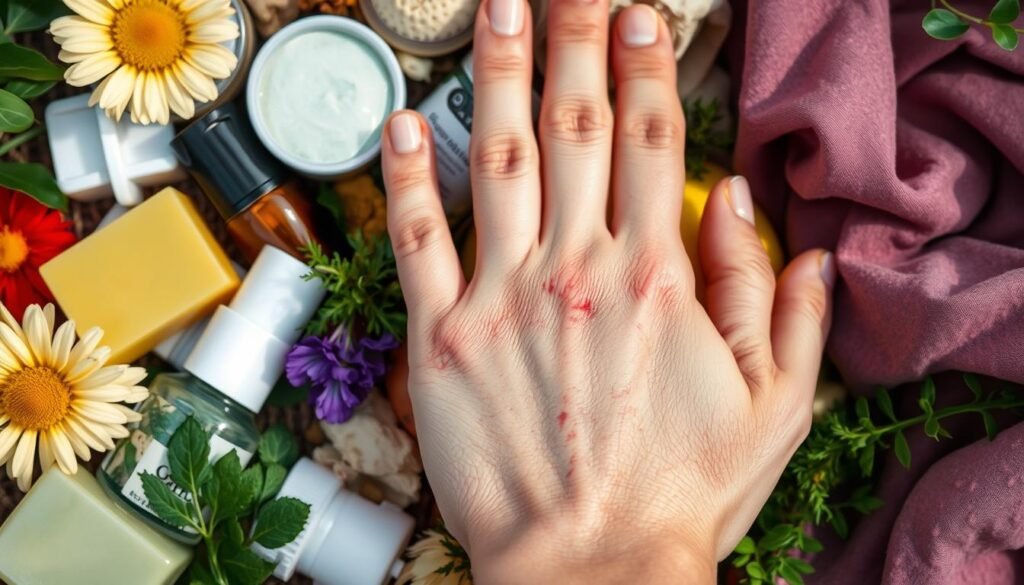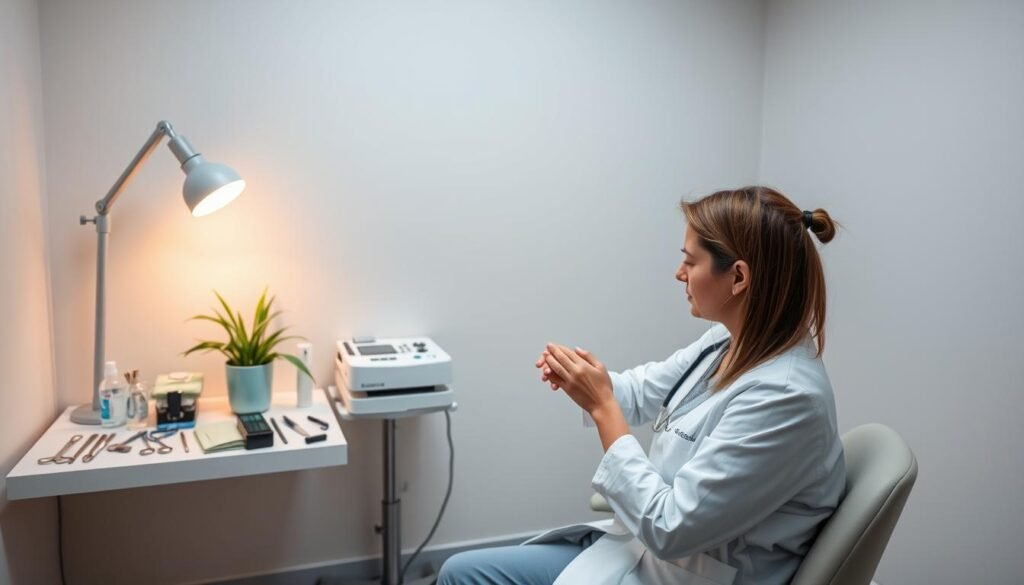Irritant contact dermatitis makes up 80% of all contact dermatitis cases. It hits not just people in jobs like healthcare or hairstyling, but anyone exposed to certain things. Something as simple as wearing rubber gloves or touching a plant could cause it. This leads to rashes, burning, and a lot of soreness. Knowing how to handle this pain is key for managing it and finding contact dermatitis relief.
The rash can pop up minutes after contact and discomfort might stick around for up to four weeks. The good news is there are ways to ease the pain and soreness of contact dermatitis. Spotting the symptoms early and taking the right steps make a big difference. It lets people feel better and move on with their day.
Key Takeaways
- Contact dermatitis is prevalent, especially for those in certain occupational fields.
- Understanding the types and causes of contact dermatitis helps in managing symptoms.
- Effective treatment can significantly reduce pain and tenderness.
- Natural remedies and soothing techniques are available for home treatment.
- Recognizing symptoms early can prevent complications from infections.
Understanding Contact Dermatitis
Contact dermatitis is an inflammatory skin condition. It results in red, inflamed skin. This happens after touching irritating substances or allergens. The contact dermatitis definition separates it into two kinds: irritant and allergic contact dermatitis.
Irritant contact dermatitis happens when harmful substances damage the skin. Chemicals can cause inflammation. This type is the most common, affecting many workers. Common sources are things like cement, hair dyes, and rubber gloves.
Allergic contact dermatitis is different. It’s a reaction to something your skin previously reacted to. This type is triggered by metals, perfumes, and glues. The allergens cause itching and a rash. Sometimes, the reaction takes months or years to show.
About 20% of kids get contact dermatitis. It’s pretty common. The symptoms look similar for both types. They include a red rash, blisters, and sometimes severe itching. Treating and preventing them require different methods, based on the dermatitis type.
Causes of Contact Dermatitis
Contact dermatitis emerges due to various external factors. These lead to skin issues and allergic reactions. Mainly, causes of contact dermatitis are allergens and irritants. Common irritants are chemicals, solvents, and cleaning agents touching the skin. Meanwhile, allergens are things that some people react to.
Poison ivy is a well-known allergen that causes allergic contact dermatitis. Metals like nickel, chrome, and mercury are also common triggers, especially in jewelry. Plus, beauty products, like hair dyes with paraphenylenediamine, may cause dermatitis.
Some medications might lead to contact dermatitis too. For instance, neomycin in antibiotic creams is a common cause. Recognizing these causes of contact dermatitis helps people avoid them, which is crucial to stop outbreaks.
Symptoms like redness, blisters, and itching can appear within hours to days after contact. Treating it involves calming the skin and finding out what caused the reaction. Patch testing is a good way to find out what the specific triggers are.
Symptoms of Contact Dermatitis
People with contact dermatitis notice different symptoms that affect their skin. The start of irritation and discomfort can be worrying. It shows the importance of noticing and acting on symptoms early. Signs to watch for include:
- Redness and swelling in the affected zone
- Itchy skin, which can get worse
- Burning or stinging feeling
- Formation of hives or rash like bumps and blisters
- Blisters full of fluid that may leak
- Skin that is dry and cracks over time
The impact of these symptoms can change based on skin sensitivity, age, and where you live. Knowing these signs helps people get the right treatment quickly. This stops the problem from getting worse. Often, feelings like pain or itching start before you can see any rash.
Contact dermatitis can happen in areas like the face, neck, underarms, and feet. It’s usually caused by touching allergens or irritants. There are thousands of things that can trigger it. So, it’s very important for people to know what causes their reactions. This helps in avoiding those triggers. Being aware and acting fast can greatly ease the discomfort of this skin issue.
| Symptom | Description |
|---|---|
| Itching | A common starting point that can make things worse if you scratch. |
| Redness | Shows swelling and irritation at the site. |
| Blisters | These are bumps filled with fluid that can irritate more when they break. |
| Dryness | Results in skin that cracks or flakes, often after being irritated for a while. |
| Burning sensation | This can come with itching, showing the skin is very sensitive. |
Some people have unexpected reactions, like symptoms on the eyelids or groin. Knowing all possible symptoms is key. Those with allergies or sensitive skin should be extra careful with new products or places. Staying proactive helps avoid the irritation and discomfort of contact dermatitis.
Identifying Irritants and Allergens
Finding out what triggers contact dermatitis is key to handle it well. You need to know both allergens and irritants that cause issues to stay clear of flare-ups. Testing is vital for people with contact dermatitis. Dermatologists do patch tests to find out what you’re sensitive to. This includes metals like nickel and various scents in daily products. Knowing what bothers you helps avoid them better.
About 80 percent of contact dermatitis cases come from irritants. Things like soaps, detergents, and solvents are common culprits. They make the skin itchy, blistered, and cracked. Handling raw fruits and veggies can also lead to allergic contact dermatitis for some. Knowing this helps people avoid these triggers in their everyday lives.
Emollients can shield and moisturize the skin. If you’re prone to contact dermatitis, wearing gloves with irritants is wise. Also, wash your skin well with warm water if you touch something risky. Checking your personal care items often can lower the risk of an allergic reaction. By pinpointing what causes your contact dermatitis, you can really cut down on symptom chances.

Dealing with Pain and Tenderness from Contact Dermatitis
Pain and tenderness often come from contact dermatitis, due to skin inflammation. Being aware of these signs is key in dealing with pain from contact dermatitis. It helps people find good ways to treat and manage it.
Recognizing Symptoms of Pain and Tenderness
Those with contact dermatitis might feel many kinds of pain and tenderness. These symptoms can include:
- Redness and swelling of the affected skin
- Itching and discomfort during daily activities
- Blisters and dry patches that may crack or bleed
- Increased sensitivity to touch
It’s important to know these signs for effective tenderness management. Spotting them early can help start treatments sooner, lessening their effect on one’s life.
Effects on Daily Life
The impact on lifestyle from contact dermatitis pain can be big. Simple actions, like washing hands or using skincare, get hard. Certain jobs, like hairdressing or nursing, may make the pain worse due to ongoing exposure to harmful substances.
| Occupation | Common Risk Factors |
|---|---|
| Hairdressers | Exposure to chemicals in dyes and products |
| Nursing Staff | Frequent hand washing and contact with patients |
| Bakers | Contact with flour and other irritants |
| Office Workers | Allergens in cosmetics and office supplies |
| Bricklayers | Exposure to moisture and dust |
Long-lasting symptoms can lower life quality and interrupt everyday habits. This pushes people to look for various relief methods.
Effective Treatment Options for Contact Dermatitis
Finding the right treatment for contact dermatitis is key. Treatments help manage symptoms and heal the skin. Topical corticosteroids and emollients are common options. They reduce inflammation and keep the skin moist. This is crucial for easing discomfort and preventing damage.
Topical Corticosteroids
Topical corticosteroids are a top choice for treating contact dermatitis. You can get them with or without a prescription. They help lessen inflammation and ease symptoms like itching and redness. Apply these creams one to two times daily for the best results. Hydrocortisone and betamethasone are popular choices. Betamethasone is for more serious cases. However, watch out for side effects like skin thinning if used for a long time.
Emollients and Moisturizers
Emollients are also vital for managing contact dermatitis. They keep the skin barrier strong and prevent dryness. This can stop irritation from getting worse. Pick emollients that work for your skin type. Use them often, especially after showers. Good skin care makes a big difference in healing and symptom relief.

| Treatment Option | Purpose | Examples |
|---|---|---|
| Topical Corticosteroids | Reduce inflammation and itching | Hydrocortisone, Betamethasone |
| Emollients | Moisturize and maintain skin barrier | Petrolatum, Glycerin-based creams |
| Systemic Corticosteroids | Treat severe conditions | Oral Prednisone |
| Phototherapy | Address resistant cases | Narrowband UVB therapy |
Home Remedies for Alleviating Contact Dermatitis Discomfort
Many people look for natural ways to ease dermatitis. They use home remedies and soothing methods. These options not only bring comfort but also let individuals control their symptoms at home. They do this without always needing drugs.
Natural Alternatives
Home remedies for contact dermatitis can really help. Here are some good choices:
- Cool compresses: A cool, damp cloth on the skin can lessen redness and swelling.
- Aloe vera: This gel reduces inflammation and moisturizes, making it a go-to solution.
- Coconut oil: Its antibacterial quality may prevent extra infections.
- Oatmeal baths: Colloidal oatmeal in warm bath water can soothe itching well.
- Apple cider vinegar: Added to bathwater, it might balance the skin’s pH levels.
Soothing Techniques
Using soothing techniques along with natural remedies can increase comfort. Here are some effective methods:
- Daily moisturization: Applying thick creams, like petroleum jelly or shea butter, twice a day helps keep skin moist.
- Wet wraps: Wet cloths can hydrate the skin during bad spells.
- Massage therapy and acupressure: These ways to manage stress can ease physical pain and make you relax.
- Stress management: Having a healthy routine with good food, some exercise, and enough sleep might lessen the symptoms.
People might find these home remedies for contact dermatitis effective. They offer a whole way of handling discomfort.
Ways to Reduce Contact Dermatitis Pain
To ease contact dermatitis pain, avoid things that cause it and manage the pain smartly. Knowing what sets off your allergies, like specific soaps or plants, is key. If you can avoid these triggers, your symptoms might not be so bad.
Putting cold packs on the skin can quickly ease pain, calming red, sore areas. Then, using creams such as hydrocortisone reduces swelling and redness. This helps your skin heal better and feel more comfortable.
Here are some additional pain management strategies:
- Washing the affected skin with mild soap and water to remove irritants.
- Keeping the skin moisturized to prevent dryness and cracking.
- Avoiding scratching to reduce the risk of infection.
- Wearing protective clothing when handling potential allergens.
- Using barrier creams for added protection against irritants.
Knowing about common irritants like bleach and some hair products can lower your risk of exposure. For people in jobs where contact with these irritants is likely, like healthcare or construction, it’s crucial to take steps to prevent dermatitis pain.
| Strategy | Description |
|---|---|
| Avoiding Triggers | Identifying and steering clear of known allergens and irritants. |
| Cold Compress | Applying cold packs to alleviate inflammation and discomfort. |
| Topical Treatments | Using OTC creams like hydrocortisone to soothe irritation. |
| Moisturization | Keeping skin hydrated prevents cracking and irritation. |
| Protective Gear | Wearing gloves and long sleeves to minimize skin exposure. |
Coping with Contact Dermatitis Sensitivity
Handling contact dermatitis begins with avoiding what triggers it. Staying away from these triggers is key in easing symptoms and stopping outbreaks. By adopting certain strategies, people can protect their skin better.
Managing Triggers and Avoidance Techniques
Knowing what causes your reactions helps in dealing with contact dermatitis. Some common irritants are:
- Poison ivy
- Nickel
- Sunscreens and fragrances
- Latex gloves
- Occasional use of makeup
To reduce exposure, one could:
- Find out personal allergens with patch testing.
- Stay away from jewelry with nickel.
- Opt for hypoallergenic makeup if needed.
- Wear protective clothes, like gloves, for risky tasks.
Protective Measures When Exposed to Irritants
If you can’t avoid triggers, protective steps are crucial. Barrier creams can guard the skin, acting as a safety layer. Also, gloves or long sleeves can block harmful substances.
For flare-ups, cold packs and gentle soaps help calm the skin. Keep the skin moisturized to make it stronger. Knowing these steps is vital for dealing with contact dermatitis, making daily life better.
| Trigger | Symptoms | Preventive Action |
|---|---|---|
| Poison Ivy | Itchy rash, blistering | Avoid contact; wear protective clothing |
| Nickel | Redness, itching | Use nickel-free jewelry |
| Latex | Swelling, hives | Utilize latex-free products |
| Fragrance | Skin irritation | Choose unscented products |
When to Seek Professional Help
Contact dermatitis can be tough, sometimes making it necessary to seek professional help for contact dermatitis. If home treatments don’t work, it might be time to see a dermatologist.
They offer special care and suggest treatments that fit your needs. This may include stronger meds than those you find in stores.

Dermatologists are also great at finding what triggers your allergies. For example, nickel is a big cause of skin reactions. Things like fragrances and natural rubber latex can also cause problems.
If not treated early, contact dermatitis can lead to long-term skin issues or infections. Knowing when to get help is crucial for dealing with this condition.
Looking into home remedies and holistic approaches is useful too. Yet, always pair these with advice from a healthcare professional.
Conclusion
Dealing with contact dermatitis means knowing the symptoms, avoiding what causes it, and treating it right. This condition can really affect someone’s life, making them feel uncomfortable and upset. To get rid of the pain and soreness, people can use creams, moisturizers, and cool wraps. Making changes to stay away from what irritates the skin is also key.
It’s also important to think about how contact dermatitis can make someone feel on the inside. Mostly because people can see the symptoms, which can be stressful. Getting help early and trying to stop flare-ups before they start can make things better. Talking regularly with doctors helps a lot. They offer great advice and support. Knowing how to handle contact dermatitis well can help people feel better about their lives, despite the challenges this condition brings.